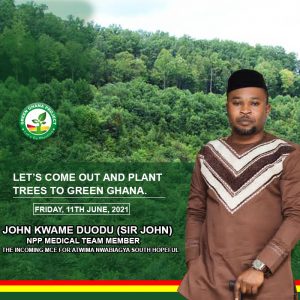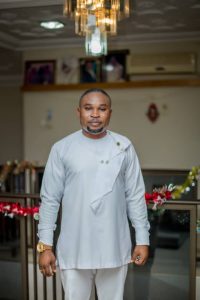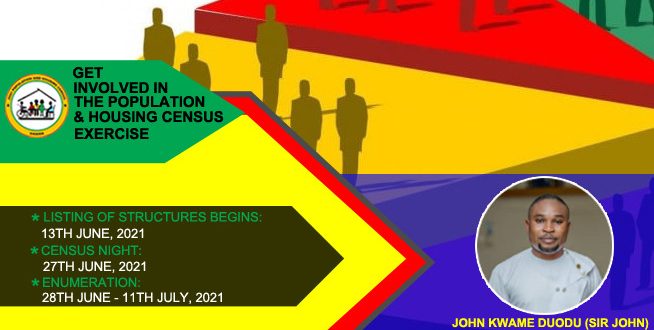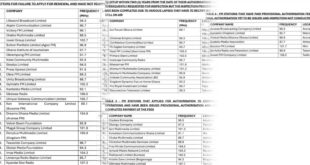2021 POPULATION AND HOUSING CENSUS.
2021 POPULATION AND HOUSING CENSUS (2021 PHC)
INTRODUCTION
Sunday 13th June marks the start of the 2021 Population and Housing Census. We are all therefore encouraged to support such exercise. We are to give accurate answer to aid in decision making for better development.
Development is about getting to know the number of people within a particular area. Numbers is also about counting. The Ghana Statistical Service (GSS) is embarking on a nationwide census so as to count each and everyone in the country. Therefore, I entreat everyone in Atwima Nwabiagya South Constituency and the Nation at large to let us all involve ourselves in the forthcoming population census.
DATE: PHASES OF 2021 PHC
13TH JUNE, 2021
1. Numbering of buildings with CHALK (chalking)
2. Asking questions of the house including number of people in the house ( listing of structures)
27TH JUNE,2021
3.Census Night
28TH JUNE- 11TH JULY 2021
4. Personal information including living conditions (Enumeration)
ASSURANCE OF THE EXERCISE
NOTE: All information are CONFIDENTIAL
BEWARE
Ensure census officers are in census jacket, and demand their introductory letter or ID card.
2021 Population and Housing Census:
NB: You Count, Get Counted
EXPECTED OUTCOMES:
Acquire skills used to obtain, evaluate and use census information as well as other types of population information used in program planning and management.
This session presents the types of information that can be obtained from the census of population and housing. It is also designed to assist planners in evaluating the quality of census information. Techniques and strategies to collect population information from other sources including representative sample surveys and vital statistics reports will also be covered.
In most countries, the census is conducted every 10 years at a minimum. For the period between census takings, information collected from representative sample surveys can be used to provide population information. Household surveys on agricultural production, manpower, health, housing, and transportation usually collect information on the characteristics of the population. These data can be used for planning purposes.
The lesson ends with a discussion of where to obtain information on vital statistics including births, deaths, fetal deaths, marriages and divorces.
WHAT IS A CENSUS
The United Nations defines a population census as the total process of collecting, compiling, and publishing demographic, economic, and social data pertaining to a specific time to all persons in a country or delimited part of a country. As part of a census count, most countries also include a census of housing. It is the process of collecting, compiling and publishing information on buildings, living quarters and building-related facilities such as sewage systems, bathrooms, and electricity, to name a few.
The United Nations lists four essential features of a census:
1. Each individual is enumerated separately; the characteristics of each person within the household are recorded separately.
2. The census covers a precisely defined territory and includes every person present or residing within its scope. The housing census should include every type of building and living quarters.
3. Each person and each type of building and living quarters is enumerated with respect to a well defined point of time.
4. The census is taken at regular defined intervals, usually every 10 years.
In most countries, people are counted in their place of usual residence.
Most censuses collect information on:
· Individual residents aged 0 to 100+
· Households including families and unrelated adults
· Workers
· Housing and related facilities.
A census of population collects information on basic population characteristics including age, sex, marital status, household composition, family characteristics, and household size. Information is also collected on economic measures including labor force participation, occupation, place of work, employment-related industry, and educational attributes such as school attendance, educational attainment, and literacy. Geographic and migration information is also collected. Questions on place of birth, place of usual residence, duration of residence, and prior place of residence allow planners to examine population movements. Some countries also collect information on births and deaths, especially those that do not have a system that adequately registers these vital events.
A census of housing collects information on buildings, living quarters and related facilities. Information is collected on buildings that are used for residential, commercial, or industrial purposes, including the type of structure, the construction materials used for the outer walls, and the year of construction. The type of information that is usually collected on living quarters includes the type and location (rural or urban locale) of the quarters, the number of rooms, the occupancy status and number of occupants, and the types of available facilities such as water, toilets, sewerage, bathing, cooking areas, and lighting. Living quarters can be housing units or collective living quarters. Data on living quarters provide insights into the type and quality of housing that exist in rural and urban areas throughout the country.
USING CENSUS INFORMATION IN PLANNING
In a number of countries, the population census plays a major role in the allocation of elected political seats in government. The number of elected officials for each governmental administrative unit is determined by the population size of a given locale. For some countries, the information is also used in the allocation of government resources. The size of the population determines, in part, the amount of money that is provided by government for development efforts.
For planners, census information is used in just about all planning decisions. The census of population provides information on the age and sex distribution, in addition to household composition and size, all of which are vital in determining the needs of different segments of the population. The census of housing allows planners to assess changes in the quality of housing and related facilities and plan for future housing needs. Table 4-1 provides possible planning-related uses for population and housing data.

IMPORTANCE AND OBJECTIVES OF CENSUS
1. It provides comprehensive and detailed data on the whole population in addition to demographic, social and economic characteristics by the lowest administrative or geographical level and related rates and indicators (population growth rates, age and gender composition, educational features, Ghana and non- Ghana workforce).
2. It provides necessary data enabling the assessment of the population status in Ghana during the inter-census period as well as monitoring demographic, social and economic changes taking place during the same period in various administrative divisions.
3. It provides data on expatriates’ number, distribution and characteristics in Ghana, especially the immigrant workforce, with a high degree of precision, instead of dependence on estimates.
4. It provides a database on which are built population projections and workforce projections
5. It provides a database needed to study specific social phenomena.
6. To provide basic data for all sectors in the country (education, health, population, etc.) with a view to contributing to the formulation, monitoring and evaluation of plans related to the provision of services needed by the Ghana society.
7. To provide necessary frameworks for deriving samples for field research to be undertaken in the future.
8. To provide data on housing units as well as their facilities and features related to living conditions, basic data needed to work out a clearly-defined housing policy aimed at ensuring prosperity for citizens, as well as indicators on houses conditions and extent of their relationship with public service
9. To provide necessary frameworks for deriving samples for field research to be undertaken in the future.
10. To provide data on housing units as well as their facilities and features related to living conditions, basic data needed to work out a clearly-defined housing policy aimed at ensuring prosperity for citizens, as well as indicators on houses conditions and extent of their relationship with public services.
11. To provide a comprehensive and modern framework for buildings, houses and households by various administrative divisions. Such framework is necessary to design and use samples for conducting various household surveys. This will be positively reflected on the accurate measurement of the various phenomena to be investigated such as fertility, mortality and migration, which are used as the basis for calculating population growth rates and estimates of the post-census population.
12. To provide an accurate picture of the status and features of houses for the purpose of assisting in drawing up housing and construction plan for the future.
13. To provide data on the features of buildings of the public sector and private sector and status of their occupation so as to define various needs in the future.
14. To define the conditions of economic and social enterprises in the public and private sectors in terms of the legal status, economic activity and workforce size by gender and nationality.
The data will help the government gather adequate information about us in order to make informed decisions that would positively affect our socio-economic welfare and formulate
and implement policies that would ensure development of our communities and the nation at large. Don’t be left out.
The Census is for all
SUMMARY AND EXERCISE
Population information is needed to guide all planning decisions. Lesson for provided sources of available census-related information and various options to evaluate the quality of information obtained. In addition, strategies for using population- related information to develop, revise, implement and evaluate sub-national plans were introduced.
· Think about how you have used population information in the past. What type of information did you obtain? Where did you obtain the information? How did you evaluate its quality?
· Identify additional sources of information. What type of information do you need? How will you use it? Where will you find it? How will you evaluate the quality?


Mr Kwame Duodu – MCE Aspirant for Atwima Nwabiagya Municipality
JOHN KWAME DUODU (SIR JOHN)
THE HOPE FOR ATWIMA NWABIAGYA MUNICIPAL ASSEMBLY
IN THE ATWIMA NWABIAGYA SOUTH CONSTITUENCY, ASHANTI REGION, GHANA
Source: MyGhanaMedia.com
Send your news stories to myghanamedia@gmail.com and Chat with us via WhatsApp on +233200818719
 MYGHANAMEDIA.COM Best Source Of Latest News
MYGHANAMEDIA.COM Best Source Of Latest News




